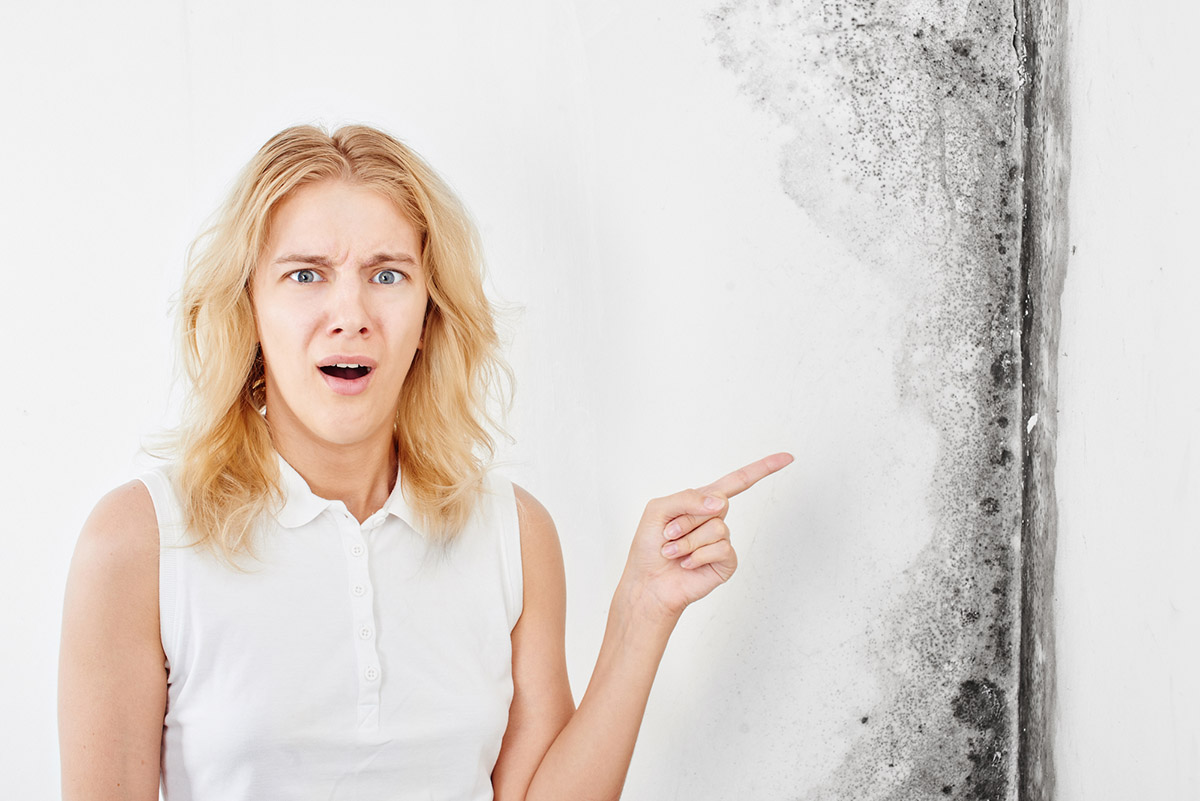

We may earn revenue from the products available on this page and participate in affiliate programs. Learn More ›
There are various types of mold in nature, many non-hazardous, but mold is not something anyone wants to see inside their home. While experts say diseases like toxic mold syndrome have no basis in science and are just media hype, mold can still cause reactions in people with allergies or weakened immune systems when it grows indoors. Toxigenic molds like black mold can also become harmful if they are left unchecked for too long. But what is black mold, specifically? What people refer to as “black mold” is a variety of mold called Stachybotrys chartarum that can be particularly tough to remove. It feeds on cellulose-rich building material like wood and drywall and can breed in damp areas. Black mold grows quickly, which is why homeowners must learn how to identify black mold as soon as possible so they can get rid of it and keep it away.
Difficulty: Beginner
Estimated cost: $8 and up if using a mold test kit
Tools & Materials
Bobvila.com may earn a commission from purchases made through these links.
Before You Begin…
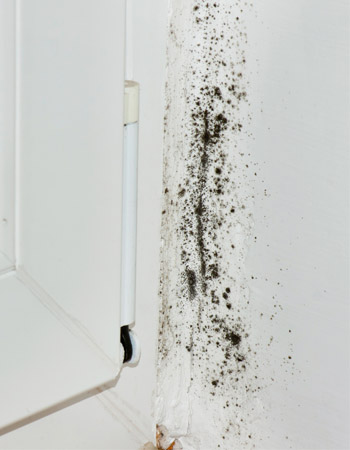
If there is a lingering musty smell in the home, or if a household member is experiencing ongoing black mold symptoms such as respiratory issues or allergic reactions, it’s smart to hire a licensed mold inspector to assess the home and test for mold. While it’s possible to learn how to identify toxic black mold yourself, it may be more challenging to identify and remove the mold without proper training.
What Are the Health Effects of Black Mold?
Upon finding black mold in their home, most homeowners’ first thought is likely to be, “Is black mold dangerous?” Rest assured that while it’s not exactly healthy, black mold is also not the most toxic mold. “Health impacts are not limited to black mold,” says David Harley, Certified Mold Inspector (CMI), Certified Mold Remediation Contractor (CMRC) and owner of AdvantaClean of Badgerland. “Black mold tends to be found outdoors and in many cases is not the more dangerous of the molds. Oftentimes mold that is white, yellow, or green can be more harmful.”
Still, black mold exposure is no joke, especially for those with allergies or compromised immune systems. Stachybotrys chartarum is a toxigenic mold, meaning that in the right setting and when allowed to go unchecked, it can produce something called mycotoxins. Spores that carry these mycotoxins get released into the air whenever the mold is disturbed. “Toxigenic mold tends to be toxic to humans regardless of any underlying [health] conditions,” says Harley. Extended exposure to toxic black mold spores can lead to respiratory issues, skin rashes, sinus inflammation, fever, and more.
Tips for How to Identify Black Mold in Your House
- Black mold feeds on cellulose and usually grows on or near building materials like drywall and wood.
- Black mold thrives in damp areas.
- Black mold often grows inside walls first, meaning homeowners can sometimes smell it before they see it.
- Black mold can grow in the bathroom, air ducts, windowsills, and the kitchen—all common sources of collected condensation.
- Sealants and grout can be vulnerable to black mold. Since they’re usually in high-moisture areas such as the shower, it’s crucial to carefully check caulk and bathroom tiles for mold.
Safety Considerations
- Always wear protective gear when identifying, touching, and cleaning any mold, including disposable coveralls, a protective face mask, airtight safety goggles, and rubber gloves.
- Clean and disinfect protective gear and tools once the mold has been assessed. Microscopic spores can linger on surfaces and grow new colonies if contacted surfaces are not adequately cleaned.
- If large amounts of black mold are present upon inspection, contact a professional mold remover immediately. If a homeowner attempts black mold removal themselves, they may leave mold spores behind, which will cause it to recolonize.
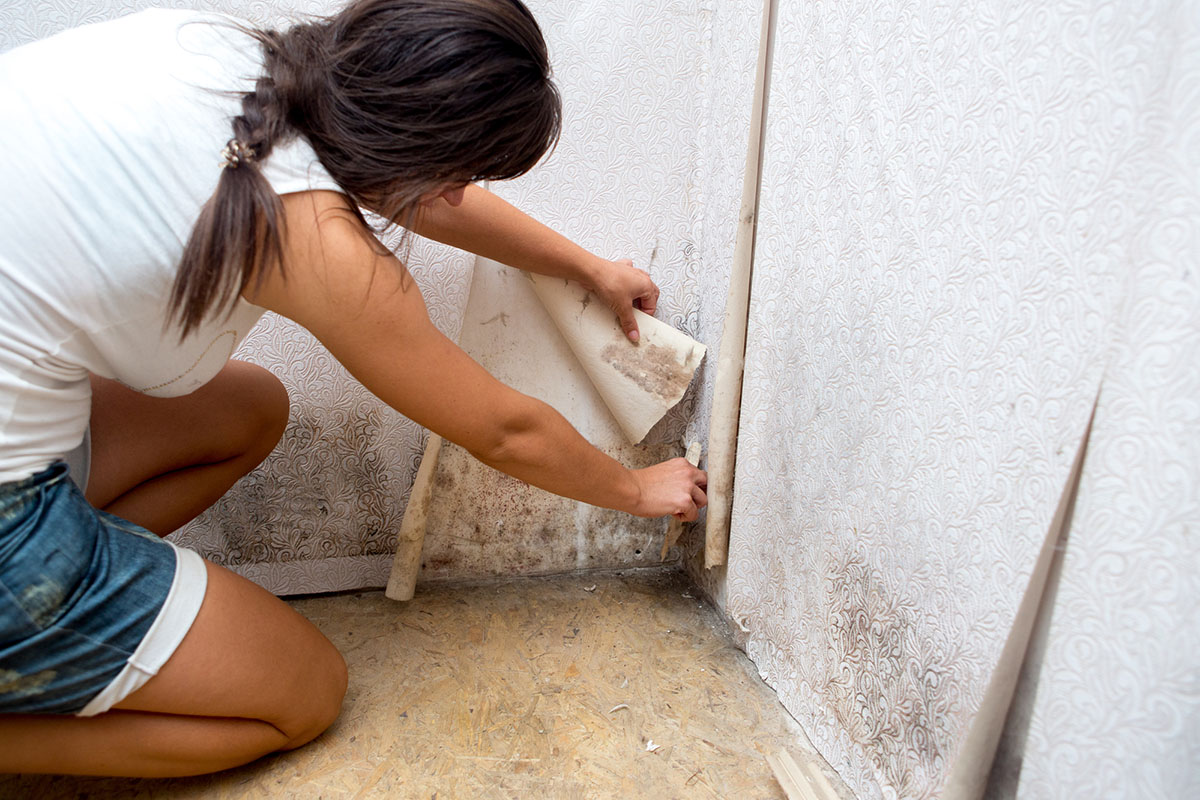
STEP 1: Inspect the color first.
What does black mold look like? As the name implies, the appearance of matured black mold is typically black, but it may appear in different colors such as dark green, dark gray, or brown before taking on its characteristic black hue.
It’s easy to mistake black mold for dust or dirt. Black mold typically has smaller spore groupings and is condensed to a secluded area. However, if it’s had time to grow in damp conditions, it may travel to different parts of the wall or room.
Identifying black mold can be tricky when it appears in different strains—some of which are white, yellow, or green. Mold that is black can be the same color as black mold and not be the same strain. The term “black mold” refers explicitly to Stachybotrys chartarum.
STEP 2: Try to find the source of a musty smell.
Homeowners may need to use their noses to sniff out the source of the black mold. Black mold may not have a strong smell if it’s just starting to grow. Once it’s matured, black mold will have a robust earth-like smell, similar to dirt or rotting leaves. Established black mold has a more pungent smell than other types of household molds.
A good place to begin the search for mold is any part of the home with lots of moisture, or an area that has been affected by water damage. Black mold in shower stalls, laundry rooms, kitchens, and basements is common. Mold likes porous, high-cellulose materials like carpet or drywall, so check ceilings, walls, and flooring in these areas.
STEP 3: Check if it has a wet and slimy texture.
While other types of mold may have a fuzzy, light texture, black mold is typically slimy or wet. Some early forms of black mold have a powdery feel. A homeowner can rub the mold with a paper towel to determine the texture, but it’s imperative to wear gloves, a face mask, coveralls, and airtight safety goggles when going near mold.
Homeowners should also take care not to touch the mold with their bare hands or touch their face with any materials that have come into contact with mold. If they touch black mold with their bare hands, it’s a good idea to run them under hot water and wash thoroughly with soap as soon as possible.
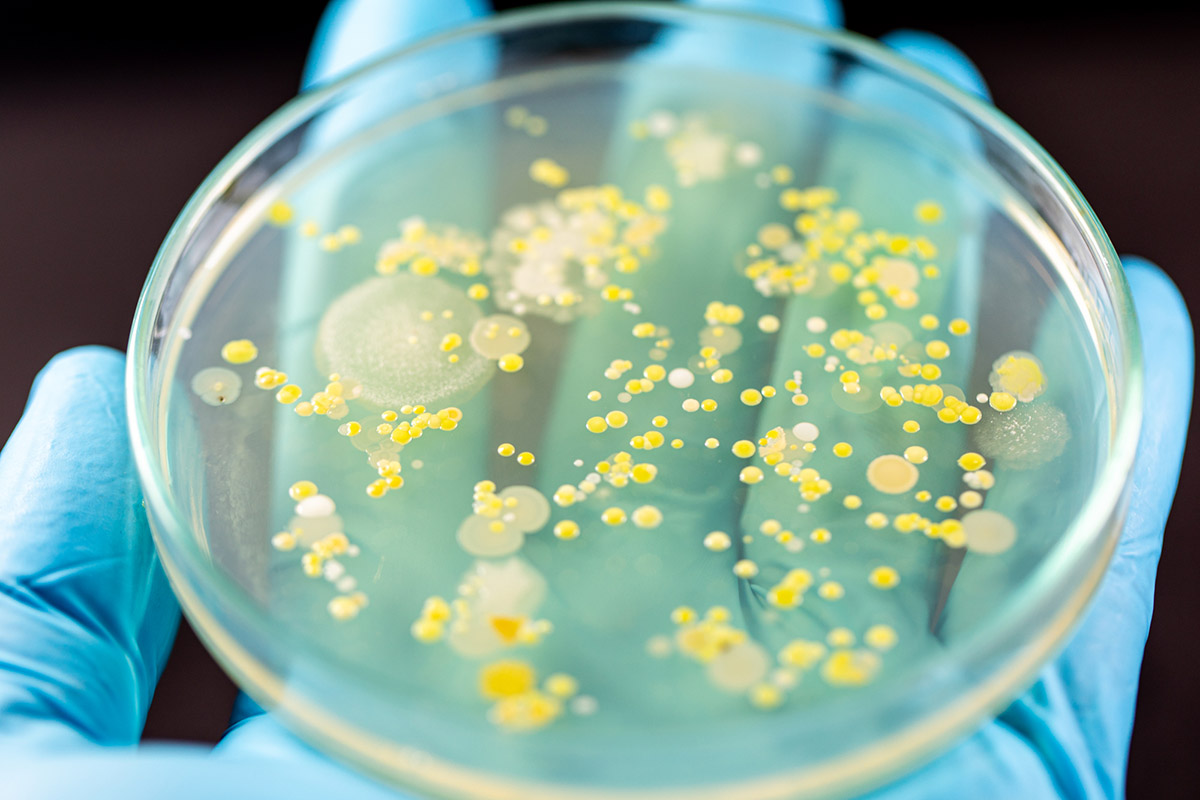
STEP 4: Use a mold test kit to confirm the presence of black mold.
Homeowners can confirm mold using a mold test kit, which can be purchased in a home improvement store or online. The best mold test kits will typically run between $30 and $40, with some advanced kits costing up to $90 and basic kits costing as little as $10.
A mold kit is not a black mold test specifically, but it can determine the presence of mold in general. To further identify the type of mold, the test must be sent to a lab. These additional analyses can run from $40 to $70. While it is not necessary to identify the type of mold present before treating it, the information may help homeowners in case the removed mold returns and they need to take additional action.
To test for mold, homeowners should follow the instructions on the test kit. The test will take about 5 days to confirm or deny the presence of mold. If the presence of mold is detected, homeowners can send the test to a lab for analysis. It can take up to 8 weeks to receive the results of the mold analysis to determine the type of mold. If time is of the essence or a household member is experiencing mold exposure symptoms, it may be more prudent to pay the cost of a mold inspection by a professional.
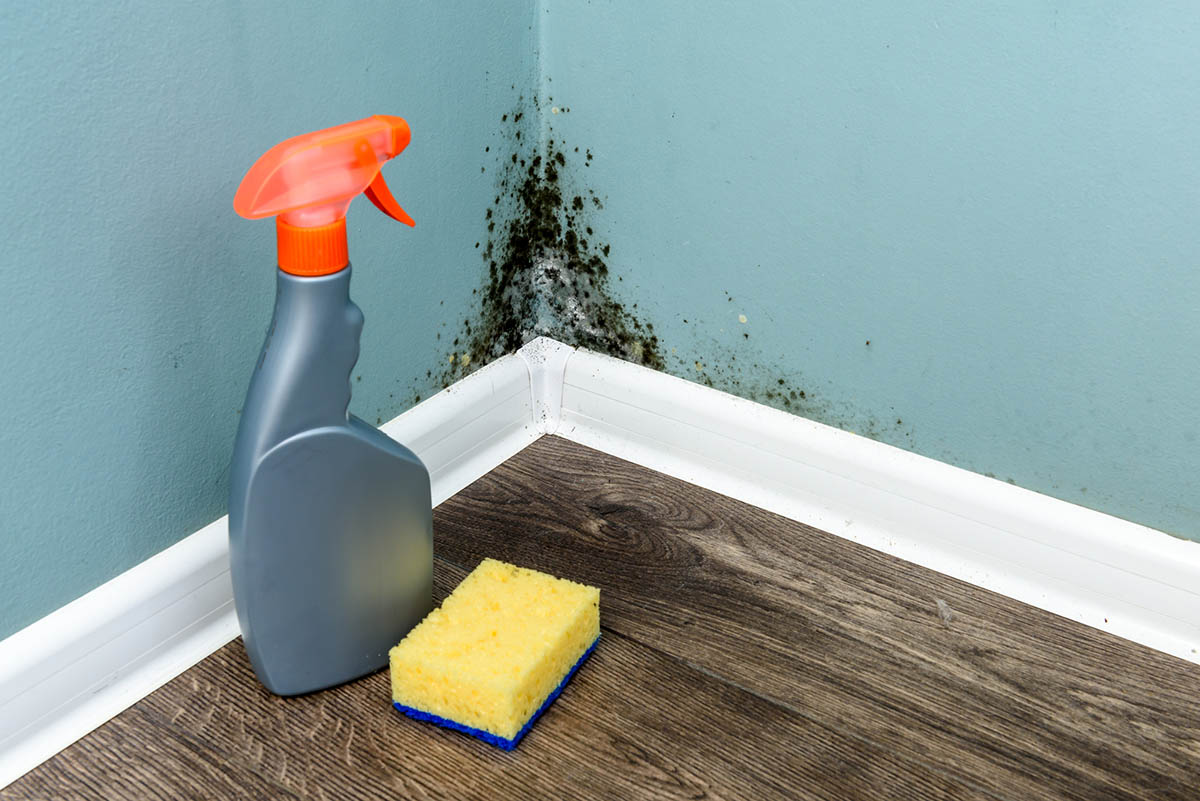
STEP 5: Create a plan for cleaning and removing the black mold in the affected area.
Once the presence of black mold has been confirmed, the homeowner must clean and remove it as soon as possible. If the black mold is in the early stages of development or is localized to a small area, it’s possible for homeowners to get rid of the black mold themselves. The homeowner can use a mold-fighting solution such as tea tree oil, sodium borate, vinegar (which can be surprisingly effective), or bleach, and clean the mold using a nylon bristle brush and old rags or paper towels.
If the black mold infestation is extensive or in a hard-to-reach spot, or if the homeowner is concerned about health hazards, the best mold removal companies and specialists will know how to clean black mold in a way that is both safe and effective.
STEP 6: Make your home inhospitable to future mold.
Once mold has been removed, it’s understandable for the homeowner to want to forget about the problem and move on. However, if the conditions that caused mold to grow in the first place are not also remedied, homeowners will likely be dealing with mold again before they know it. Homeowners may need professional assistance to ensure they know how to kill mold like black mold in their homes once and for all.
“You always need to be monitoring your environment to ensure conditions don’t return that would invite regrowth of the organism,” says Victor Coppola, senior building biologist and founder of GreenWorks Environmental, LLC. It’s important to understand why the mold occurred in the first place in order to keep it at bay. Improper ventilation in the home, leaky pipes, or condensation are all possible culprits, as moisture is typically the common denominator.
According to Harley, “Mold needs three things to grow: a food source, consistent temperature, and moisture. Excess moisture tends to be the reason mold grows in homes in the first place. If you take care of the excess moisture in the home, you will be able to inhibit future mold growth.”
These tips will help homeowners learn how to identify and how to get rid of black mold. When in doubt, spending money on the cost for professional mold remediation is the surest way for homeowners to help ensure their home stays mold-free in the future.
